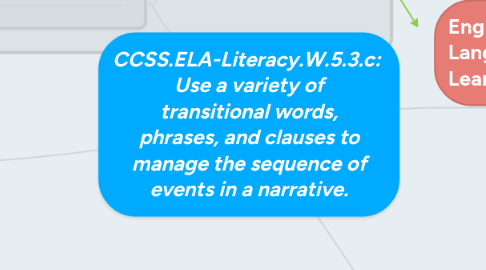
1. Below Grade Level
1.1. Differentiation Strategy 1: STORYBOARD
1.1.1. As students learn about how not only recognize but USE transitional words and phrases in their own writing, using images can be helpful for those students who may be struggling to grasp the concept or for learners who are below grade level. This strategy helps students visualize the concept at hand. Students will put a transitional word in each box of the story board and then draw what is happening in the narrative, putting the events into logical order. They will then expand on the transitional word to create an entire sentence that starts off the event depicted.
1.2. Differentiation Strategy 2: TEAMWORK
1.2.1. Students work together in pairs to create a narrative story using a list of transitional words that the teacher provides. This allows students to support each other, allowing student below grade level to seek help from their peers, and those who may already grasp the concept expand their understanding by explaining to their classmate.
2. Timeline Toolkit
2.1. This online tool can be useful for both ELL students and those who are below grade level as it helps them organize their ideas and develop a logical sequence of events while doing so in a visual, hands on way.
3. -- When planning a lesson, it is extremely important to keep in mind who your audience is. Being aware your student’s ability and comprehension levels helps you adapt your lesson to meet their needs, giving certain students the extra or specialized attention they may need. Being familiar with your students interests is very helpful as well as it allows you to bridge the gap between what they enjoy outside of school and what triggers their interest in class. Working to combine the two allows for a more engaging lesson as students are more involved and motivated when they are interested. -- A great way to learn about student interests is to pass out index cards on the first day of school on which students will fill in information about their favorite hobbies, activities and pastimes, as well as their favorite subjects in school. They will also be asked some questions about their native language, nationality and cultural background as well as their preferred learning style, helping them identify the way in which they best assimilate new information. -- Using the strategies I listed (Storyboard; Teamwork; Think, Pair, Share; Appropriate Reading Level) are easy and effective ways of adapting a lesson to meet various student needs. I especially like these specific strategies because they simply modify the lesson so that all students are working on the same activity but with the appropriate adjustments to enhance their learning experience and allow them to achieve the desired objectives. I also think differentiation that involves partner work is very positive and effective as it engages students of different levels and helps them learn how to support one another in their learning experiences.
4. English Language Learner
4.1. Differentiation Strategy 1: THINK, PAIR, SHARE
4.1.1. As we study transitional words and phrases, this can be quite difficult for students, let alone those who are non-native English speakers. This strategy allows students to think on their own, coming up with as many ideas as they can, then pair up with a partner, with whom they can share their ideas and discuss similar or different findings. The pair their shares what they have found with the class. This is a great strategy for ELL students as it allows them the opportunity to think on their own first, without any aid, but before sharing with the class they are able to go over their findings with a partner, allowing them to ask questions or clarify any confusion they experienced.
4.2. Differentiation Strategy 2: APPROPRIATE READING LEVEL
4.2.1. In having students read a narrative and identify transitional words, it is important to adapt the reading material to ELL student comprehension level. While the text should be comprehensible to the student, it should not bee too simple either.
